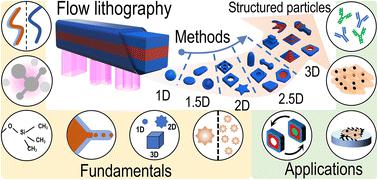Our official English website, www.x-mol.net, welcomes your
feedback! (Note: you will need to create a separate account there.)
Flow lithography for structured microparticles: fundamentals, methods and applications
Lab on a Chip ( IF 6.1 ) Pub Date : 2022-08-03 , DOI: 10.1039/d2lc00421f Mehmet Akif Sahin 1 , Helen Werner 1 , Shreya Udani 2 , Dino Di Carlo 2, 3 , Ghulam Destgeer 1
Lab on a Chip ( IF 6.1 ) Pub Date : 2022-08-03 , DOI: 10.1039/d2lc00421f Mehmet Akif Sahin 1 , Helen Werner 1 , Shreya Udani 2 , Dino Di Carlo 2, 3 , Ghulam Destgeer 1
Affiliation

|
Structured microparticles, with unique shapes, customizable sizes, multiple materials, and spatially-defined chemistries, are leading the way for emerging ‘lab on a particle’ technologies. These microparticles with engineered designs find applications in multiplexed diagnostics, drug delivery, single-cell secretion assays, single-molecule detection assays, high throughput cytometry, micro-robotics, self-assembly, and tissue engineering. In this article we review state-of-the-art particle manufacturing technologies based on flow-assisted photolithography performed inside microfluidic channels. Important physicochemical concepts are discussed to provide a basis for understanding the fabrication technologies. These photolithography technologies are compared based on the structural as well as compositional complexity of the fabricated particles. Particles are categorized, from 1D to 3D particles, based on the number of dimensions that can be independently controlled during the fabrication process. After discussing the advantages of the individual techniques, important applications of the fabricated particles are reviewed. Lastly, a future perspective is provided with potential directions to improve the throughput of particle fabrication, realize new particle shapes, measure particles in an automated manner, and adopt the ‘lab on a particle’ technologies to other areas of research.
中文翻译:

结构化微粒的流动光刻:基础、方法和应用
具有独特形状、可定制尺寸、多种材料和空间定义化学成分的结构化微粒正在引领新兴的“粒子实验室”技术。这些具有工程设计的微粒可用于多重诊断、药物递送、单细胞分泌测定、单分子检测测定、高通量细胞术、微型机器人、自组装和组织工程。在本文中,我们回顾了基于在微流体通道内执行的流动辅助光刻技术的最先进的粒子制造技术。讨论了重要的物理化学概念,为理解制造技术提供了基础。这些光刻技术是根据所制造颗粒的结构和成分复杂性进行比较的。根据制造过程中可以独立控制的维度数量,对粒子进行分类,从 1D 到 3D 粒子。在讨论了各个技术的优点之后,回顾了制造颗粒的重要应用。最后,为提高粒子制造的吞吐量、实现新的粒子形状、以自动化方式测量粒子以及将“粒子实验室”技术应用于其他研究领域的潜在方向提供了未来的前景。
更新日期:2022-08-03
中文翻译:

结构化微粒的流动光刻:基础、方法和应用
具有独特形状、可定制尺寸、多种材料和空间定义化学成分的结构化微粒正在引领新兴的“粒子实验室”技术。这些具有工程设计的微粒可用于多重诊断、药物递送、单细胞分泌测定、单分子检测测定、高通量细胞术、微型机器人、自组装和组织工程。在本文中,我们回顾了基于在微流体通道内执行的流动辅助光刻技术的最先进的粒子制造技术。讨论了重要的物理化学概念,为理解制造技术提供了基础。这些光刻技术是根据所制造颗粒的结构和成分复杂性进行比较的。根据制造过程中可以独立控制的维度数量,对粒子进行分类,从 1D 到 3D 粒子。在讨论了各个技术的优点之后,回顾了制造颗粒的重要应用。最后,为提高粒子制造的吞吐量、实现新的粒子形状、以自动化方式测量粒子以及将“粒子实验室”技术应用于其他研究领域的潜在方向提供了未来的前景。











































 京公网安备 11010802027423号
京公网安备 11010802027423号